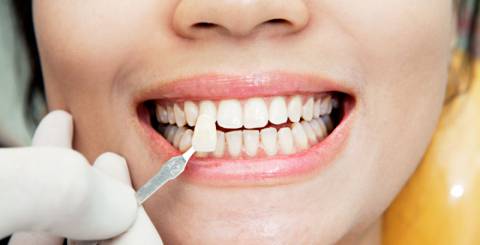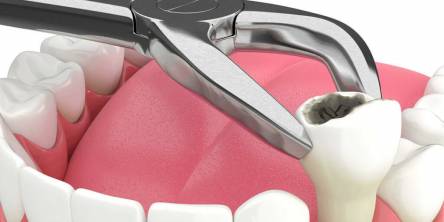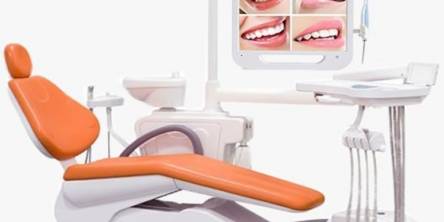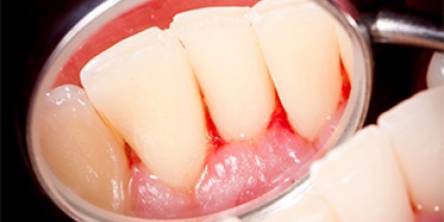What is the Difference Between Direct and Indirect Veneers?

Are you satisfied with the appearance of your front teeth or do they have some imperfections you’d like to hide? Most of us are not entirely happy with the way our smile looks and this is where dental veneers are frequently an excellent solution.
When to Consider Veneers
Veneers can do a fantastic job at masking all sorts of problems with the appearance of teeth. For example, it’s worth considering veneers if you have teeth that are internally stained. Teeth that are internally stained will not respond to normal teeth whitening treatments and will often benefit from being covered up entirely.
Minor chips, cracks or worn areas are often easily mended with veneers. Unsightly spaces between teeth can be closed or at least minimized. If you have one or two teeth that are slightly out of alignment or which are rotated, one option is to have adult orthodontics, but veneers can be a more immediate and more cost-effective solution. To sum up, veneers can normally correct crooked, wonky, or unsightly teeth in a very short period.
What Are Direct Veneers?
Direct veneers are made from a material called composite resin which, as the name suggests, is applied directly to the surface of teeth. The tooth surfaces are first prepared with a special etching liquid that slightly roughens the surface. Etching the surface creates a stronger bond between the composite resin and the tooth. Once the composite resin is applied to the tooth surface, it is then hardened, shaped and polished, and in the hands of a skilled cosmetic dentist can look very natural.
Direct veneers are a nice option because very little tooth preparation is needed and often treatment is completed during a single dental visit. The effect is subtle yet noticeable, and it’s extremely cost-effective. One thing to bear in mind about direct veneers is that composite resin can eventually stain, and especially if you like highly colored foods and beverages or if you smoke. Usually, composite resin veneers need renewing after a few years to ensure they remain looking good.
This treatment can also be combined with another procedure called enamel reshaping, where a minimal amount of tooth enamel is removed from tooth surfaces to reshape the tooth gently. For example, this could be useful if you have a tooth that is slightly crooked or overlapping or is perhaps just a bit too long. Again, the effect is subtle, but it can really make a difference.
What Are Indirect Veneers?
Indirect veneers are made outside the mouth using a strong and durable porcelain material. The porcelain veneers are bonded onto prepared tooth surfaces and can create dramatic transformations. It’s an effect that is often used by people in the public eye to create smiles that look cosmetically perfect. When multiple veneers are placed, and which cover up most or all the front teeth, it’s even possible to lighten the overall shade of teeth, creating an effect that will last for years.
The preparation for indirect veneers is much more involved compared with direct veneers. Usually, it’s necessary for the dentist to remove 0.5 mm from the tooth surfaces to create enough room for the veneer. Unless this amount is removed, the veneer will most look and feel too bulky. However, some types of veneers are called prep-less veneers or no-prep veneers and where the porcelain veneer is made from a much thinner type of laminate and is typically just 0.2 mm in thickness. With this type of veneer, minimal preparation might be required, but it all depends on the position of your teeth and the type of transformation desired.
When tooth material must be removed, this is completed using a local anesthetic to ensure you do not feel any discomfort or sensitivity. Afterward, a detailed dental impression is taken of the prepared teeth and is sent to the dental lab so the veneers can be custom-made to your cosmetic dentist’s exact prescription. While the veneers are being fabricated, your teeth are protected with temporary veneers. At your next visit, your permanent veneers are fitted and adjusted if necessary, before they are bonded onto your tooth surfaces.
One advantage of choosing porcelain veneers is their longevity. Depending on the porcelain used, they can last 10 years or even 20 years or more before they need replacing. Because modifications are frequently necessary to place these veneers, treatment is normally irreversible. Once you have your veneers, you will always need to protect your teeth, and you will need to budget for their replacement in the years to come. Unlike composite resin, porcelain veneers will not stain or change color. Instead, they should remain looking as good as the day they were fitted.
How to Decide If Veneers Are for You
Deciding whether to have dental veneers is quite a big decision, and quite understandably one concern many people have is how their teeth will look once treatment is completed. There are a couple of different ways you can more clearly visualize your new smile, and one is using digital technology. Nowadays, many dental offices offer a smile design service where they will manipulate digital images of your teeth to show how they will appear once treatment is completed. The images can then be altered until you are happy with the design.
Otherwise, another option is to have an impression taken of your teeth as they are, and the impression is used to create a plaster model. The plaster model is then modified using tooth-colored wax to make what’s called a diagnostic wax-up of your teeth showing the proposed changes to your smile. Although a bit more involved, this method does allow you to assess the appearance of your teeth fully, as the wax can be altered until you are happy with the appearance.
Once you are satisfied with the mock-up of your smile or with the diagnostic wax-up, these designs can be used to create temporary veneers. These veneers are worn after your teeth are prepared and while your permanent veneers are being fabricated. Trialing your smile in this way allows you to get the opinions of loved ones and friends, and to make any adjustments to the appearance of your veneers before the permanent veneers are created.
Similar Articles
Ah, the bittersweet moment when a tooth has overstayed its welcome. It’s been with you through thick and thin—chewing your favorite snacks, smiling in photos, and grinding during those stressful nights. But now, it’s time to part ways
Learn 5 signs you may need dentures and discover the steps to get started for a healthier smile and improved quality of life.
Boost patient trust and diagnostic accuracy with high-quality intraoral cameras. Enhance care, improve communication, and streamline operations in your dental practice!
Imagine this: You just walked out of the dentist's office after your laser gum contouring procedure, and your smile is on the verge of greatness: no more gummy grins or uneven gum lines. You’re practically ready to hit the red carpet. But hold up — what happens next? How fast can you expect to heal after your gums get their laser makeover?
Have you ever wondered how orthodontic treatment has evolved over the years? Are you curious about the latest innovations in teeth straightening technology? Have you heard about Invisalign but aren't quite sure how it works or if it's right for you? If you've found yourself pondering these questions, you're not alone.
Gingivitis is an inflammation of the gums that often develops unnoticed in the early stages. However, if left untreated, it can lead to severe complications. In this article, we look at five essential facts about gingivitis that will help you better understand this disease and take the necessary steps to prevent and treat it.
Everyone is looking for that movie star smile but we think to ourselves that it’s going to cost too much money and so we give up on the dream. You would be surprised at what can be achieved at your local dental clinic and people have gone in through the doors and came out a short time later with an unbeatable smile that may be even better than the TV and movie stars that we see every single day
Dental implants fundamentally changed the concept of replacing teeth.
Cosmetic dentistry is a branch of dentistry that focuses on enhancing the function and appearance of a patient's smile. Cosmetic dentistry near you is frequently elective, but it can provide numerous restorative benefits. Depending on the type of cosmetic treatment you have, most are rather easy, while some are more difficult









